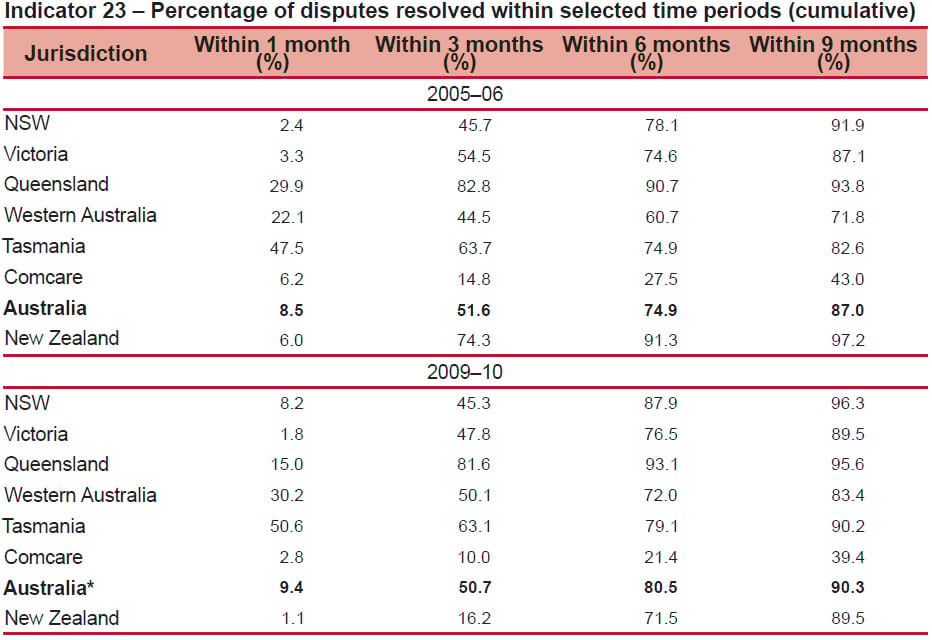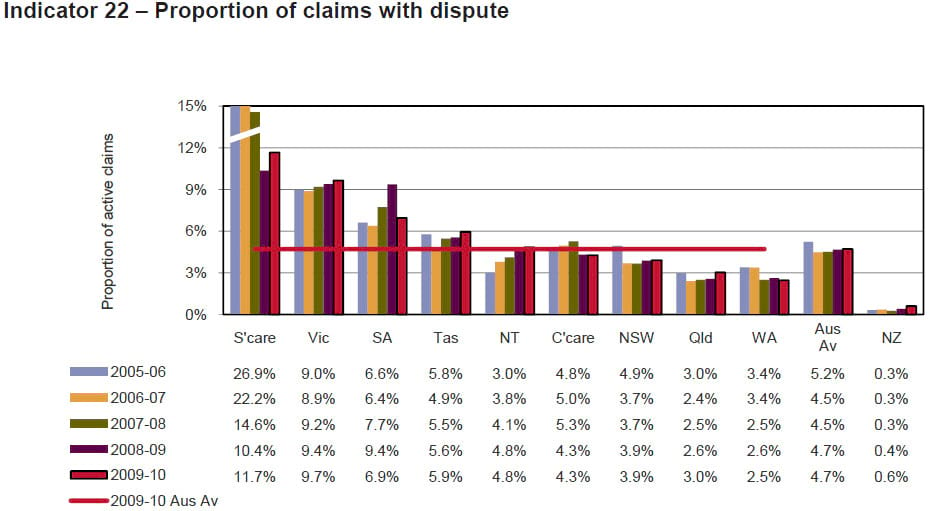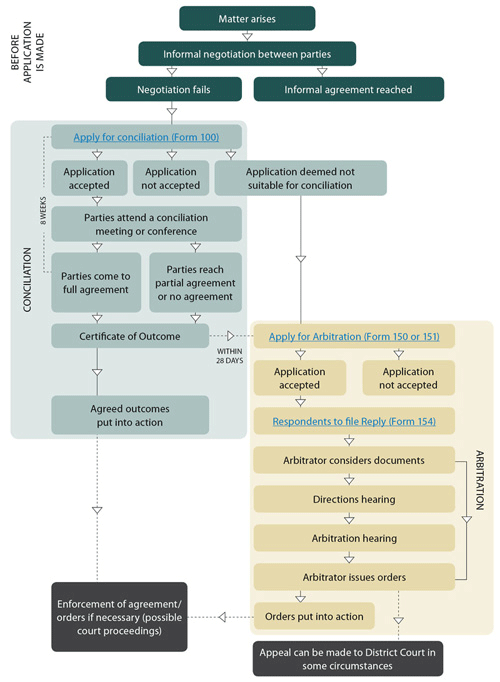Consider the alternative: Part 6 - Western Australia

In Part 6 of our ongoing series on the use of Alternative Dispute Resolution in workers’ compensation disputes we talk to WorkCover WA. New to the series? Take a look at previous articles:
- Part 1 – An Introduction to Alternative Dispute Resolution
- Part 2 – What makes a good workers' comp system with Nerida Wallace, Principal of Transformation Management
- Part 3 – Victoria
- Part 4 – New South Wales with Sian Leathem, Registrar of the NSW Workers Compensation Commission
- Part 5 - Queensland with Elizabeth Woods, CEO of Q-COMP
WORKERS' COMP IN W.A BY THE NUMBERS
Resolution Rates

Table from the 2008-2009 Comparative Performance Monitoring Report (p. 37)
Despite comfortably boasting the second highest resolution rate within the 1 month period (30.2%, over three times greater than the national average of 9.4%), WA falls away to hold the lowest rates of any State for periods up to 6 and 9 months. Of course, the report asks us to treat the numbers with ‘caution’, and speaks only to the efficiency, not effectiveness, but the raw numbers reflect those of a system in need of a shake up.
The good news is, on 1 December 2011 a shake up was delivered in the form of the Workers' Compensation and Injury Management Amendment Act 2011, which places a large emphasis on system efficiency (more on that later).
Disputation Rate

Table from the 2008-2009 Comparative Performance Monitoring Report (p. 38)
In the 09-10 period WA's disputation rate was 2.5%, the lowest of any State or Territory and well below the national average of 4.7%. Since 04-05, no state outside of Queensland has had such a consistently low disputation rate.
According to WorkCover WA, in 2009-10 38,126 workers compensation claims were made, 1,517 disputes lodged, and 18 appeals made to the Commissioner.
THE NEW WA WORKERS’ COMPENSATION MODEL

Chart from WorkCover WA's website detailing the new system - Conciliation & Arbitration: Overview
The former workers' compensation system was a two-tied process incorporating conciliation and arbitration. Its defining characteristic was the involvement of a single Arbitrator throughout the first three stages of the process.
The new model separates the conciliation and arbitration processes, and attempts to improve overall timeliness as well as ease of access and use.
Stage 1: Parties must attempt to settle the matter informally - NEGOTIATION
Before a party can lodge an application for conciliation with WorkCover WA they must make a 'reasonable attempt' to resolve the dispute through informal negotiations with the opposing party.
Regardless of whether not these discussions are successful, they will have allowed each party to become familiar with the issues in dispute and the viewpoint of the other side.
Step 2: If dispute cannot be resolved by negotiation - CONCILIATION
WorkCover WA describes conciliation as "parties in dispute coming to their own agreement, with the assistance of an independent Conciliation officer."
(a) Application
Once a party makes an application for conciliation it can be:
- accepted (matter proceeds);
- rejected (documents are returned along with reasons for rejection); or
- deemed not suitable for conciliation (party is required to make an application to the Arbitration Service).
(b) Discussion
If a matter does proceed to conciliation:
- the Conciliation Service may contact each party to discuss the dispute (some matters are resolved at this stage); and if this fails,
- a conciliation meeting is scheduled to take place at WorkCover WA (and within 21 days of the initial application being accepted).
Where there are medical issues in dispute (such as the precise nature of a worker's injury or their capacity to work), the matter can be referred to a medical panel. These panels (made up of unbiased medical practitioners) may require a physical examination before delivering a final and binding opinion on the matter.
(c) Conclusion
Following the conciliation process the parties are issued a Certificate of Outcome which according to WorkCover WA outlines:
- "the matters in dispute at the outset of the process";
- "those matters that were resolved and the basis on which they were resolved";
- "those matters remaining in dispute" and
- "details of any payment directions issued."
Step 3: if all issues in dispute are not resolved by conciliation or the matters is not deemed suitable for conciliation - ARBITRATION
(a) Application
A party must lodge their application with the Arbitration Service within 28 days of receiving the Certificate of Outcome.
If the application is accepted, the party who submitted it ("the applicant") must send a copy of the application and any supporting documents to the other party (or parties) to the dispute (the "respondent/s").
The respondent/s then have 14 days to complete their reply, which must include an account of how they see the dispute and any documents they plan to use to substantiate their position at arbitration.
(b) Arbitration
The parties then take part in arbitration, which WorkCover WA describes as "a formal recorded proceeding at which evidence is heard and a legally qualified Arbitrator makes a final determination."
Much like a court trial, each party may present witnesses in support of their case and then the Arbitrator reviews all of the evidence before coming to a decision.
(c) Conclusion
The Arbitrator will provide orders (a binding and legally enforceable account of the arbitration's outcome) along with reasons for his or her decision. If the orders require one party to pay the other a sum or sums of money, and payment is not made, the party breaching the order may be taken before the Magistrates Court or the District Court of WA to force their compliance.
If a party is not satisfied with the outcome of arbitration, they can appeal to the District Court of WA within 28 days of the Arbitrator providing the reasons for his or her decision.
WHAT’S WORKING WELL
Feedback from the WorkCover WA Injured Workers’ Survey
In 2010 WorkCover WA commissioned an independently conducted survey of 704 injured workers on how well WA’s workers’ compensation system was operating. Findings of note included:
- 83% ‘believed they were treated fairly’
- 77% ‘were working at the time of the survey’
- 76% ‘were satisfied with their overall workers’ compensation experience’
Interestingly, while system efficiency has been identified as an issue by the resolution rates and addressed in the recent reforms, those surveyed seemed less concerned with the speed of the resolution, and more concerned about the quality and outcome of the process. The main reasons for being dissatisfied with the system were:
- Lack of communication (30.5%)
- Problems with the compensation payment (20.7%); and
- Timeliness of the service (15.9%)
HOW THEY ARE MAKING IT BETTER
WA have committed to making significant changes through the introduction of the new system which came into effect on 1 December 2011. According to WorkSafe WA, “the new system will be more accessible and will provide a quicker means of resolving disputes.”
Change as the result of government monitoring
The changes came on the back of a 2009 legislative review, part of which focused on seeking stakeholder feedback on how dispute resolution processes were performing. “Consistent feedback” suggested that current processes:
- “do not provide the opportunity for early conciliation;
- are complex, expensive and labour intensive to make an application;
- lack a focus on timeliness and are process rather than outcome driven; and
- are compromised as a result of arbitrators exercising both conciliation and arbitration functions.”
Key aspects of the new system
Seeking to improve the efficiency, accessibility and quality of the system, the amendments will establish:
- “a Conciliation Service headed by a Director;
- firm timelines governing process and certain powers for conciliation officers to make directions for the payment, suspension and temporary reduction of benefits;
- an Arbitration Service headed by a Registrar in which arbitrators and the Registrar are legal practitioners. The sole focus of the Arbitration Service will be the determination of matters not resolved by the Conciliation Service;
- clear rules to govern procedure in both services, with a focus on timeliness;
- simplified access to the process of conciliation by the removal of the requirement to provide all documentation at the commencement of the process (i.e. no front loading);
- retention of legal representation and costs at both stages (conciliation and arbitration); and
- transfer of appellate jurisdiction to the District Court of Western Australia.”
In short, the reforms are focused on separating the conciliation and arbitration processes, making things easier for parties to make an application, and delivering more efficient outcomes.
THE BOTTOM LINE
The resolution rate data and survey feedback both indicated that it was time for change in WA. Thankfully the WA Government has come to the party, and through the Workers' Compensation and Injury Management Amendment Act 2011 it appears to have addressed a number of the key concerns raised about the previous system. Return To Work Matters looks forward to seeing how the system operates, and what impact it has on the quality of outcomes.

